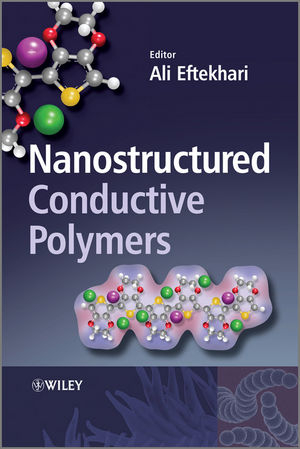
Nanostructured Conductive Polymers
John Wiley & Sons Inc (Verlag)
978-0-470-74585-4 (ISBN)
- Titel z.Zt. nicht lieferbar
- Versandkostenfrei innerhalb Deutschlands
- Auch auf Rechnung
- Verfügbarkeit in der Filiale vor Ort prüfen
- Artikel merken
Ali Eftekhari is Professor of Chemistry and Director of the Avicenna Institute of Technology in Cleveland (USA). He received his PhD at Trinity College (Ireland). From 2000 to 2002, he was a researcher at Nirvan Co. (USA) working on an environmental project under support of former Vice-President Al Gore. From 2002 to 2004, Professor Eftekhari was senior researcher at KICR (USA), working on a joint corporate project based in United States and Iran. For the next two years, he was Head of the Electrochemistry Division at the Materials and Energy Research Center in Iran. Since 2007, Ali Eftekhari has been Professor of Chemistry and Director of Avicenna Institute of Technology. He is the editor of four books including Nanostructured Materials in Electrochemistry (Wiley) and editor of the book Boltzmann Philosophy of Science. Professor Eftekhari is Editor of the Journal of Nanomaterials and has been chairman or on the Editorial Advisory Boards of several conferences. His research interests include electrochemistry, nanoscience and nanotechnology, statistical physics, condensed matter physics, philosophy, the history of science, management and science policy.
Preface xv
Foreword xix
List of Contributors xxi
Part One 1
1 History of Conductive Polymers 3
J. Campbell Scott
1.1 Introduction 3
1.2 Archeology and Prehistory 7
1.3 The Dawn of the Modern Era 8
1.4 The Materials Revolution 12
1.5 Concluding Remarks 13
Acknowledgments 15
References 15
2 Polyaniline Nanostructures 19
Gordana Ćirić-Marjanović
2.1 Introduction 19
2.2 Preparation 21
2.2.1 Preparation of Polyaniline Nanofibers 21
2.2.2 Preparation of Polyaniline Nanotubes 42
2.2.3 Preparation of Miscellaneous Polyaniline Nanostructures 52
2.3 Structure and Properties 60
2.3.1 Structure and Properties of Polyaniline Nanofibers 60
2.3.2 Structure and Properties of Polyaniline Nanotubes 63
2.4 Processing and Applications 64
2.4.1 Processing 64
2.4.2 Applications 65
2.5 Conclusions and Outlook 74
References 74
3 Nanoscale Inhomogeneity of Conducting-Polymer-Based Materials 99
Alain Pailleret and Oleg Semenikhin
3.1 Introduction: Inhomogeneity and Nanostructured Materials 99
3.2 Direct Local Measurements of Nanoscale Inhomogeneity of Conducting and Semiconducting Polymers 101
3.2.1 Introduction 101
3.2.2 Atomic Force Microscopy (AFM), Kelvin Probe Force Microscopy (KFM), and Electric Force Microscopy (EFM) 103
3.2.3 Current-Sensing Atomic Force Microscopy (CS-AFM) 105
3.2.4 Scanning Tunneling Microscopy (STM) and Scanning Tunneling Spectroscopy (STS) 109
3.2.5 Phase-Imaging Atomic Force Microscopy (PI-AFM) and High-Resolution Transmission Electron Microscopy (HRTEM): Studies of Local Crystallinity 112
3.2.6 Near-Field Scanning Optical Microscopy (NSOM) 124
3.3 In situ Studies of Conducting and Semiconducting Polymers: Electrochemical Atomic Force Microscopy (EC-AFM) and Electrochemical Scanning Tunneling Microscopy (EC-STM) 128
3.3.1 Introduction 128
3.3.2 EC-AFM Investigations of the Swelling/Deswelling of ECPs 129
3.3.3 EC-STM Investigations of the Swelling/Deswelling of ECPs 140
3.3.4 Scanning Electrochemical Microscopy (SECM) Investigations of ECPs 141
3.4 The Origin of the Nanoscale Inhomogeneity of Conducting and Semiconducting Polymers 144
References 151
Part Two 161
4 Nanostructured Conductive Polymers by Electrospinning 163
Ioannis S. Chronakis
4.1 Introduction to Electrospinning Technology 163
4.2 The Electrospinning Processing 164
4.3 Electrospinning Processing Parameters: Control of the Nanofiber Morphology 165
4.3.1 Solution Properties 165
4.3.2 Process Conditions 166
4.3.3 Ambient Conditions 167
4.4 Nanostructured Conductive Polymers by Electrospinning 168
4.4.1 Polyaniline (PANI) 168
4.4.2 Polypyrrole (PPy) 175
4.4.3 Polythiophenes (PThs) 179
4.4.4 Poly(p-phenylene vinylenes) (PPVs) 183
4.4.5 Electrospun Nanofibers from Other Conductive Polymers 186
4.5 Applications of Electrospun Nanostructured Conductive Polymers 187
4.5.1 Biomedical Applications 187
4.5.2 Sensors 194
4.5.3 Conductive Nanofibers in Electric and Electronic Applications 197
4.6 Conclusions 201
References 201
5 Composites Based on Conducting Polymers and Carbon Nanotubes 209
M. Baibarac, I. Baltog, and S. Lefrant
5.1 Introduction 209
5.2 Carbon Nanotubes 212
5.2.1 Synthesis of CNTs: Arc Discharge, Laser Ablation, Chemical Vapor Deposition 214
5.2.2 Purification 217
5.2.3 Separation Techniques for Metallic and Semiconducting Carbon Nanotubes 219
5.2.4 Vibrational Properties of Carbon Nanotubes 222
5.3 Synthesis of Composites Based on Conducting Polymers and Carbon Nanotubes 224
5.3.1 Polyaniline/Carbon Nanotubes 225
5.3.2 Polypyrrole/Carbon Nanotubes 228
5.3.3 Poly(3,4-ethylenedioxythiophene)/Carbon Nanotubes 229
5.3.4 Poly(2,2 0 -bithiophene)/Carbon Nanotubes 229
5.3.5 Poly(N-vinylcarbazole)/Carbon Nanotubes 230
5.3.6 Polyfluorenes/Carbon Nanotubes 231
5.3.7 Poly(p-phenylene) Vinylene/Carbon Nanotubes 231
5.3.8 Polyacetylene/Carbon Nanotubes 232
5.4 Vibrational Properties of Composites Based on Conducting Polymers and Carbon Nanotubes 233
5.4.1 Conducting Polymer/Carbon Nanotube Bilayer Structures 233
5.4.2 Covalently Functionalized Carbon Nanotubes with Conducting Polymers 233
5.4.3 Conducting Polymers Doped with Carbon Nanotubes 244
5.4.4 Noncovalent Functionalization of Carbon Nanotubes with Conducting Polymers 247
5.5 Conclusions 249
Acknowledgments 250
References 250
6 Inorganic-Based Nanocomposites of Conductive Polymers 261
Rabin Bissessur
6.1 Introduction 261
6.2 FeOCl 262
6.3 V 2 O 5 Systems 263
6.4 Vopo 4 .2h 2 O 273
6.5 MoO 3 274
6.6 Layered Phosphates and Phosphonates 277
6.7 Layered Rutiles 279
6.8 Layered perovskites 280
6.9 Layered Titanates 280
6.10 Graphite Oxide 281
6.11 Conclusions 283
Acknowledgements 284
References 284
7 Metallic-Based Nanocomposites of Conductive Polymers 289
Vessela Tsakova
7.1 Introduction 289
7.2 Oxidative Polymerization Combined with Metal-Ion Reduction (One-Pot Synthesis) 290
7.3 Nanocomposite Formation by Means of Pre-Synthesized Metal Nanoparticles 294
7.4 Metal Electrodeposition in Pre-Synthesized CPs 297
7.4.1 Size and Size Distribution of Electrodeposited Metal Particles 305
7.4.2 Spatial Distribution of Electrodeposited Metal Particles 308
7.4.3 Number Density of Electrodeposited Metal Particles 310
7.5 Chemical Reduction of Metal Ions in Pre-Polymerized CP Suspensions or Layers 312
7.5.1 Use of the Polymer Material as Reductant 312
7.5.2 Use of Additional Reductant 320
7.6 Metallic-Based CP Composites for Electrocatalytic and Electroanalytic Applications 321
List of Acronyms 325
References 325
8 Spectroscopy of Nanostructured Conducting Polymers 341
Gustavo M. do Nascimento and Marcelo A. de Souza
8.1 Synthetic Metals 341
8.2 Nanostructured Conducting Polymers 342
8.3 Spectroscopic Techniques 344
8.3.1 Vibronic Techniques (UV-vis-NIR, FTIR, Raman, Resonance Raman) 345
8.3.2 X-Ray Techniques (XANES, EXAFS AND XPS) 346
8.4 Spectroscopy of Nanostructured Conducting Polymers 349
8.4.1 Nanostructured Polyaniline and its Derivates 349
8.4.2 Nanostructured Poly(Pyrrole) 355
8.4.3 Nanostructured Poly(Thiophenes) 358
8.4.4 Nanostructured Poly(Acetylene) and Poly(Diacetylene) and their Derivates 361
8.5 Concluding Remarks 364
Acknowledgements 365
References 365
9 Atomic Force Microscopy Study of Conductive Polymers 375
Edgar Ap. Sanches, Osvaldo N. Oliveira Jr, and Fabio Lima Leite
9.1 Introduction 375
9.2 AFM Fundamentals and Applications 376
9.2.1 Basic Principles 376
9.2.2 Imaging Modes 377
9.2.3 Force Spectroscopy 399
9.3 Concluding Remarks 405
Acknowledgments 406
References 406
10 Single Conducting-Polymer Nanowires 411
Yixuan Chen and Yi Luo
10.1 Introduction 411
10.2 Fabrication of Single Conducting-Polymer Nanowires (CPNWs) 412
10.2.1 Lithographical Methods 412
10.2.2 Scanning-Probe-Based Techniques 418
10.2.3 Template-Guided Growth or Patterning 426
10.2.4 Other Methods 436
10.3 Transport Properties and Electrical Characterization 443
10.3.1 Background 443
10.3.2 Brief Summary of Transport in 3-D CP Materials 444
10.3.3 Conductivity of CP Nanowires, Nanofibers, and Nanotubes 446
10.3.4 Summary 449
10.4 Applications of Single Conducting Polymer Nanowires (CPNWs) 449
10.4.1 CPNW Chemical and Biological Sensors 450
10.4.2 CPNW Field-Effect Transistors 453
10.4.3 CPNW Optoelectronic Devices 455
10.5 Summary and Outlook 460
References 460
11 Conductive Polymer Micro- and Nanocontainers 467
Jiyong Huang and Zhixiang Wei
11.1 Introduction 467
11.2 Structures of Micro- and Nanocontainers 468
11.2.1 Hollow Spheres 468
11.2.2 Tubes 472
11.2.3 Others 474
11.3 Preparation Methods and Formation Mechanisms 478
11.3.1 Hard-Template Method 478
11.3.2 Soft-Template Method 482
11.3.3 Micro- and Nanofabrication Techniques 485
11.4 Properties and Applications of Micro- and Nanocontainers 486
11.4.1 Chemical and Electrical Properties 487
11.4.2 Encapsulation 488
11.4.3 Drug Delivery and Controlled Release 490
11.5 Conclusions 494
References 495
12 Magnetic and Electron Transport Behaviors of Conductive-Polymer Nanocomposites 503
Zhanhu Guo, Suying Wei, David Cocke, and Di Zhang
12.1 Introduction 503
12.2 Magnetic Polymer Nanocomposite Preparation 506
12.2.1 Solution-Based Oxidation Method 506
12.2.2 Electropolymerization Method 507
12.2.3 Two-Step Deposition Method 508
12.2.4 UV-Irradiation Technique 508
12.3 Physicochemical Property Characterization 509
12.4 Microstructure of the Conductive Polymer Nanocomposites 509
12.5 Interaction between the Nanoparticles and the Conductive-Polymer Matrix 510
12.6 Magnetic Properties of Conductive-Polymer Nanocomposites 512
12.7 Electron Transport in Conductive-Polymer Nanocomposites 515
12.8 Giant Magnetoresistance in Conductive-Polymer Nanocomposites 520
12.9 Summary 522
12.9.1 Materials Design Perspective 524
References 524
13 Charge Transfer and Charge Separation in Conjugated Polymer Solar Cells 531
Ian A. Howard, Neil C. Greenham, Agnese Abrusci, Richard H. Friend, and Sebastian Westenhoff
13.1 Introduction 531
13.1.1 Polymer: PCBM Solar Cells 532
13.1.2 Polymer: Polymer Solar Cells 533
13.1.3 Polymer: Inorganic Nanoparticle Solar Cells 534
13.2 Charge Transfer in Conjugated Polymers 534
13.2.1 Excitons as the Primary Photoexcitations 535
13.2.2 Charge Transfer at Semiconductor Heterojunctions 535
13.2.3 Charge Transport 537
13.2.4 Photoinduced Charge Transfer 538
13.2.5 Onsager–Braun Model of Charge-Transfer State Dissociation 540
13.2.6 Charge Formation from High-Lying Singlet States in a Pristine Polymer 541
13.2.7 Field-Assisted Charge Generation in Pristine Materials 541
13.2.8 Charge Generation in Donor: Acceptor Blends 542
13.2.9 Mechanisms of Charge-Transfer State Recombination 544
13.3 Charge Generation and Recombination in Organic Solar Cells with High Open-Circuit Voltages 545
13.3.1 Exciton Ionization at Polymer: Polymer Heterojunctions 546
13.3.2 Photoluminescence from Charge-Transfer States 547
13.3.3 The Nature of the Charge-Transfer States 549
13.3.4 Probing the Major Loss Mechanism in Organic Solar Cells with High Open-Circuit Voltages 550
13.3.5 Geminate Recombination of Interfacial Charge-Transfer States into Triplet Excitons 552
13.3.6 The Exchange Energy of Interfacial Charge-Transfer States in Semiconducting Polymer Blends 555
13.4 Conclusions and Outlook 555
Acknowledgements 556
References 556
Part Three 563
14 Nanostructured Conducting Polymers for (Electro)chemical Sensors 565
Anthony J. Killard
14.1 Introduction 565
14.2 Nanowires and Nanotubes 566
14.3 Nanogaps and Nanojunctions 568
14.4 Nanofibers and Nanocables 570
14.5 Nanofilms 572
14.6 Metallic Nanoparticle/Conducting-Polymer Nanocomposites 574
14.7 Metal-Oxide Nanoparticles/Conducting-Polymer Nanocomposites 575
14.8 Carbon Nanotube Nanocomposites 577
14.9 Nanoparticles 579
14.10 Nanoporous Templates 582
14.11 Application Summaries 583
14.12 Conclusions 593
References 594
15 Nanostructural Aspects of Conducting-Polymer Actuators 599
Paul A. Kilmartin and Jadranka Travas-Sejdic
15.1 Introduction 599
15.2 Mechanisms and Modes of Actuation 600
15.2.1 Ion Movement and Conducting-Polymer Electrochemistry 600
15.2.2 Bilayer and Trilayer Actuators 600
15.2.3 Linear Actuators and the Inclusion of Metal Contacts 602
15.2.4 Out-of-Plane Actuators 603
15.2.5 Effect of Synthesis Conditions 604
15.3 Modelling Mechanical Performance and Developing Device Applications 604
15.3.1 Modelling of Conducting-Polymer Actuation 605
15.3.2 Applications of Conducting-Polymer Actuators 607
15.4 Effect of Morphology and Nanostructure upon Actuation 610
15.4.1 Chain Alignment 610
15.4.2 Anisotropy 612
15.4.3 Porosity 614
15.4.4 Conformational Changes 614
15.5 Solvent and Ion Size Effects to Achieve Higher Actuation 615
15.5.1 Effect of Ion Size 615
15.5.2 Ionic Liquids 616
15.5.3 Ions Producing Large Actuation Strains 617
15.6 Nanostructured Composite Actuators 619
15.6.1 Blends of Two Conducting Polymers 619
15.6.2 Graphite 620
15.6.3 Carbon Nanotubes 620
15.6.4 Hydrogels 621
15.6.5 Other Interpenetrating Networks 621
15.7 Prospects for Nanostructured Conducting-Polymer Actuators 622
References 623
16 Electroactive Conducting Polymers for the Protection of Metals against Corrosion: from Micro- to Nanostructured Films 631
Pierre Camille Lacaze, Jalal Ghilane, Hyacinthe Randriamahazaka and Jean-Christophe Lacroix
16.1 Introduction 631
16.2 Protection Mechanisms Induced by Conducting Polymers 633
16.2.1 Displacement of the Electrochemical Interface 634
16.2.2 Ennobling the Metal Surface 637
16.2.3 Self-healing Effect with Doping Anions as Corrosion Inhibitors 645
16.2.4 Barrier Effect of the Polymer 650
16.3 Conducting-Polymer Coating Techniques for Usual Oxidizable Metals: Performances of Conducting-Polymer-Based Micron-Thick Films for Protection against Corrosion 656
16.3.1 Coatings Consisting of a Conducting Primer Deposited by Electropolymerization 656
16.3.2 Coatings Made from Conducting-Polymer Formulations 662
16.4 Nanostructured Conducting-Polymer Coatings and Anticorrosion Protection 665
16.4.1 Improving ECP Adhesion to Oxidizable Metals 666
16.4.2 Nanostructured Surfaces Displaying Superhydrophobic Properties 667
16.5 Conclusions 671
Acknowledgement 672
References 672
17 Electrocatalysis by Nanostructured Conducting Polymers 681
Shaolin Mu and Ya Zhang
17.1 Introduction 681
17.2 Electrochemical Synthetic Techniques of Nanostructured Conducting Polymers 682
17.2.1 Synthesis by Cyclic Voltammetry 682
17.2.2 Synthesis by Potentiostat 686
17.2.3 Synthesis by Galvanostat 690
17.3 Electrocatalysis at Nanostructured Conducting-Polymer Electrodes 692
17.3.1 Electrocatalysis by Pure Nanostructured Conducting Polymers 692
17.3.2 Electrocatalysis at the Electrodes of Conducting-Polymer Nanocomposites 695
17.4 Conclusion 700
References 701
18 Nanostructured Conductive Polymers as Biomaterials 707
Rylie A. Green, Sungchul Baek, Nigel H. Lovell, and Laura A. Poole-Warren
18.1 Introduction 707
18.2 Biomedical Applications for Conductive Polymers 708
18.2.1 Electrode Coatings 708
18.2.2 Alternate Applications 709
18.3 Polymer Design Considerations 711
18.3.1 Conduction Mechanism 711
18.3.2 Conventional Components 712
18.3.3 Biofunctional Additives 714
18.4 Fabrication of Nanostructured Conductive Polymers 715
18.4.1 Electrodeposition 717
18.4.2 Chemical Synthesis 718
18.4.3 Alternate Processing Techniques 720
18.5 Polymer Characterization 724
18.5.1 Surface Properties 724
18.5.2 Mechanical Properties 725
18.5.3 Electrical Properties 725
18.5.4 Biological Performance 726
18.6 Interfacing with Neural Tissue 727
18.7 Conclusions 728
References 729
19 Nanocomposites of Polymers Made Conductive by Nanofillers 737
Haiping Hong, Dustin Thomas, Mark Horton, Yijiang Lu, Jing Li, Pauline Smith, and Walter Roy
19.1 Introduction 737
19.2 Experimental 742
19.2.1 Materials and Equipment 742
19.2.2 Preparation of Nanocomposite (Nanotube Grease) 745
19.3 Results and Discussion 748
19.3.1 Thermal and Electrical Properties of Nanocomposites (Nanotube Greases) 748
19.3.2 Rheological Investigation of Nanocomposite (Nanotube Grease) 750
19.3.3 Nanocomposites (Nanotube Greases) with Magnetically Sensitive Nanoparticles 754
19.3.4 Electrical Conductivities of Various Nanofillers (Nanotubes) 759
19.4 Conclusion 761
Acknowledgments 761
References 762
Index 765
| Erscheint lt. Verlag | 2.8.2010 |
|---|---|
| Verlagsort | New York |
| Sprache | englisch |
| Maße | 175 x 248 mm |
| Gewicht | 1531 g |
| Themenwelt | Naturwissenschaften ► Chemie |
| Technik ► Maschinenbau | |
| ISBN-10 | 0-470-74585-1 / 0470745851 |
| ISBN-13 | 978-0-470-74585-4 / 9780470745854 |
| Zustand | Neuware |
| Haben Sie eine Frage zum Produkt? |
aus dem Bereich


